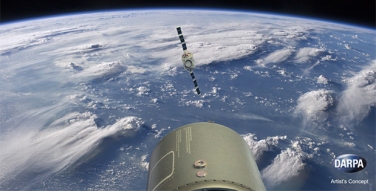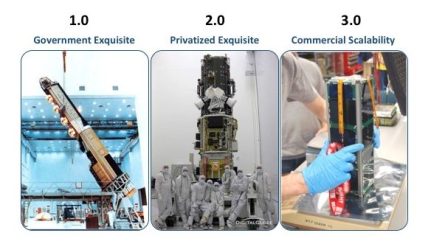
Picture Credit: DARPA (artist rendition)
DARPA is building “a completely new architecture for space.” In order to protect these vital military space systems, this research agency spawned by the launch of Sputnik in 1958 is now focused on developing a “whole portfolio” of capabilities. Before the release of British Interplanetary Society member and Futurist Arthur C. Clarke‘s seminal 1945 paper describing the launch of satellites, he first referenced geostationary satellites in his February 1945 letter to the editor of Wireless World (page 58) titled Peacetime Uses for V2 for Ionosphere Research.
The U.S. Military must instead have been paying attention to D.A. Bell’s adjacent letter regarding ” FM Protection Against High Amplitude Interference Pulse” which was a precursor of signal disruption in FM broadcasting and now a core broadcasting consideration. (D)ARPA established the IPTO in 1962 with a mandate to build a survivable computer network to interconnect the DoD’s main computers at the Pentagon, Cheyenne Mountain, and SAC HQ. As described in the following pages, this initiative led to the development of the ARPANET seven years later, and then to the NSFNET and the Internet.
In 2010, Oak Ridge National Labs (FERC – META- R-320 here) warned of U.S. power grid vulnerability from the threat of “early-time (E1) high-altitude electromagnetic pulse (HEMP) produced by nuclear detonations above an altitude of ~30 km.” Not only are HEMP (EMP) and cybersecurity prominent national security risks today, but so is the militarization of space. Two authors writing in the SAIS Journal of International Affairs last winter claimed the need for electric grid modernization was prompted by the threat from “Mother Nature” (SAIS, Vol 35, No.1) – sorry, unlike Slate, neither Oak Ridge National Labs (see EIS report here) and DARPA (to name two experts among many) do not see climate change as the real risk to critical infrastructure.
The DOD reported this week that “national security critically depends on space, and the Defense Advanced Research Projects Agency (DARPA’s Project List is detailed here) is focused today on creating the capabilities needed to help make that environment a real-time operational domain, DARPA Director Dr. Arati Prabhakar said recently at the 2016 DefenseOne Summit as reported in Air Force Magazine:
Because there “is more and more a real possibility” of conflict in space, “there is nothing that we need either from an intelligence perspective or a military perspective that we can do effectively without space.”
DARPA Director Arati Prabhakar
Its Airborne Launch Assist Space Access program (ALASA) plans to create a low cost alternative for small satellite launches and Space.com has the DARPA simulation here. They explain: “ALASA seeks to propel 100-pound satellites into low Earth orbit (LEO) within 24 hours of call-up, all for less than $1 million per launch.” The $10K/pound payload cost does not reflect total program cost but is a third of the current cost DARPA estimates but it is certainly not an all-in programmatic cost estimate. Right now, ramp times for unexpected launch operations number in the months.

A critical part of the portfolio will be DARPA reliance on its experimental spaceplane, XS-1 which entered phase 2 of its development this past spring. The Experimental Spaceplane (XS-1) program aims to help overcome cost, deployment and positioning challenges and create a “new paradigm” for more routine, responsive and affordable space operations. Jess Sponable, DARPA program manager. “We intend to leverage those advances along with our Phase 1 progress to break the cycle of escalating DoD space system launch costs, catalyze lower-cost satellite architectures, and prove that routine and responsive access to space can be achieved at costs an order of magnitude lower than with today’s systems.” DARPA has a history of being responsive to challenges:
DARPA’s ability to adapt rapidly to changing environments and to seek and embrace opportunities in both technology and in processes, while maintaining the historically proven principles of the Agency, makes DARPA the crown jewel in Defense R&D and a unique R&D organization in the world.
– DARPA Over the Years, August 1997.
So, how does DARPA frame the goal of making space a real-time operating domain (RTOD)? DARPA’s OpenCatalog actually labels these mixed-criticality real-time threats. Their Iron Curtain Active Protection System has an amazing video here of how it operates. Partnering with non-profit strategic venture investor In-Q-Tel, DARPA is going to have to rely on trusted national partners and allies. IQT Labs are exploring new ideas, technology, and approaches in select sectors that are anticipated to significantly impact national security. Under the Space 3.0 Program, a number of initiatives are underway.

Picture Credit: IQT Labs
Unlike Government exquisite systems (Space 1.0) or commercial exquisite systems (Space 2.0), Space 3.0 is being driven by venture-backed startups that are leveraging a variety of converging factors to produce a new wave of affordable products and services. From reliable space access to new analytics for remote sensory data, startups are disrupting current processes and establishing a new space ecosystem.
One particularly relevant IQT Labs effort is centered at CosmiQ Works which brings together the U.S. Intelligence Community, industry, and academia “to explore the art of the possible in the new space ecosystem.”
Inside the Next Startup Garage
Space is hard. Luckily, there are several converging advances that are helping startups launch, sometimes literally, entirely new product lines.
 Access to Space
Access to Space
Low-Earth Orbit (LEO) to be specific. New launch vehicles and rideshare options are increasing access and decreasing costs.
Cheap(er) Hardware
Adoption of commodity hardware coupled with the use of agile development methods.
Rapid Innovation
Lower costs and fast development allow startups to accept greater risks.
New Consumers
Affordability and tailored services are opening the space market to new customers.
Investment in a Commercial Ecosystem
Venture firms are investing in the new ecosystem ranging from launch systems to data analytics.